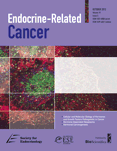The role of fibroblast growth factors and their receptors in prostate cancer
- B Kwabi-Addo,
- M Ozen and
- M Ittmann
- Department of Pathology, Baylor College of Medicine and Michael E DeBakey Department of Veterans Affairs Medical Center, Houston, Texas 77030, USA
- (Requests for offprints should be addressed to M Ittmann, Research Service, Michael E DeBakey VAMC, 2002 Holcombe Blvd, Houston, Texas 77030, USA; Email: mittmann{at}bcm.tmc.edu)
Abstract
Prostate cancer is the most common malignancy in men in the USA and the second leading cause of cancer deaths. Fibroblast growth factors (FGFs), including FGF1 (acidic FGF), FGF2 (basic FGF), FGF6 and FGF8 are all expressed at increased levels in prostate cancer as paracrine and/or autocrine growth factors for the prostate cancer cells. In addition, increased mobilization of FGFs from the extracellular matrix in cancer tissues can increase the availability of FGFs to cancer cells. Prostate cancer epithelial cells express all four types of FGF receptors (FGFR-1 to -4) at variable frequencies. Expression of FGFR-1 and FGFR-4 is most closely linked to prostate cancer progression, while the role of FGFR-2 remains controversial. Activation of FGF receptors can activate multiple signal transduction pathways including the phospholipase Cγ, phosphatidyl inositol 3-kinase, mitogen-activated protein kinase and signal transducers and activators of transcription (STAT) pathways, all of which play a role in prostate cancer progression. Sprouty proteins can negatively regulate FGF signal transduction, potentially limiting the impact of FGF signaling in prostate cancer, but in a significant fraction of prostate cancers there is decreased expression of Sprouty1 mRNA and protein. The effects of increased FGF receptor signaling are wide ranging and involve both the cancer cells and surrounding stroma, including the vasculature. The net result of increased FGF signaling includes enhanced proliferation, resistance to cell death, increased motility and invasiveness, increased angiogenesis, enhanced metastasis, resistance to chemotherapy and radiation and androgen independence, all of which can enhance tumor progression and clinical aggressiveness. For this reason, the FGF signaling system it is an attractive therapeutic target, particularly since therapies targeting FGF receptors and/or FGF signaling can affect both the tumor cells directly and tumor angiogenesis. A number of approaches that could target FGF receptors and/or FGF receptor signaling in prostate cancer are currently being developed.
- © 2004 Society for Endocrinology













